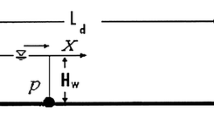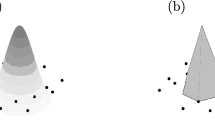Abstract
In this paper, a numerical meshless method called the weakly compressible smoothed particle hydrodynamic (WCSPH) method, which is a two-dimensionalmodel of a weakly compressible fluid, is applied to simulate the plunging wave breaking process. This model solves the viscous fluid equations to obtain the velocity and density fields and also solves the equation of state to obtain the pressure field. The WCSPH method is demonstrated to have a higher computational efficiency than the basic SPH model. To simulate the turbulent behavior of the fluid flow in the wave breaking procedure, a sub particle scale (SPS) model is used, which is obtained from the Large eddy simulation (LES) theory. To consider the accuracy of the standard WCSPH model (WCSPH model without considering the turbulent effect), a dam break test is performed, and model results are compared with available experimental data.
Similar content being viewed by others
References
M. J. F. Stive, “Energy Dissipation in Waves Breaking on Gentle Slopes,” Coastal Eng. 8(2), 99–127 (1984).
D. J. Skyner, C. Gray, and C. A. Greated, “A Comparison of Time-Stepping Numerical Predictions with Whole-Field Flow Measurement in Breaking Waves,” NATO ASI Ser., Ser. E: Appl. Sci. 178, 490–508 (1990).
J. C. Lin and D. Rockwell, “Evolution of a Quasi-Steady Breaking Wave,” J. Fluid Mech. 302, 29–44 (1995).
F. C. K. Ting and J. T. Kirby, “Dynamics of Surf-Zone Turbulence in a Spilling Breaker,” Coastal Eng. 27(3/4), 131–160 (1996).
P. Hull and G. Müller, “An Investigation of Breaker Heights, Shapes and Pressures,” Ocean Eng. 29(1), 59–79 (2002).
F. Harlow and E. Welch, “Numerical Calculation of Time-Dependent Viscous Incompressible Flow of Fluid with Free Surface,” Phys. Fluids 8(12), 2182–2189 (1965).
C. W. Hirt and B. D. Nichols, “Volume of Fluid (VOF) Method for the Dynamics of Free Boundaries,” J. Comput. Phys. 39(1), 201–225 (1981).
R. K. C. Chan and R. L. Street, “A Computer Study of Finite-Amplitude Water Waves,” J. Comput. Phys. 6(1), 68–94 (1970).
P. Lin and P. L. F. Liu, “A Numerical Study of Breaking Waves in the Surf Zone,” J. Fluid Mech. 359(1), 239–264 (1998).
L. Lucy, “A Numerical Approach to Testing the Fission Hypothesis,” Astronom. J. 82(12), 1013–1024 (1977).
R. A. Gingold and J. J. Monaghan, “Smoothed Particle Hydrodynamics-Theory and Application to Non-Spherical Stars,” Monthly Notices Roy. Astronom. Soc. 181, 375–389 (1977).
J. J. Monaghan, “Smoothed Particle Hydrodynamics,” Annual Rev. Astronomy Astrophys. 30, 543–574 (1992).
J. P. Morris, P. J. Fox, and Y. Zhu, “Modeling Low Reynolds Number Incompressible Flows using SPH,” J. Comput. Phys. 136(1), 214–226 (1997).
J. J. Monaghan and A. Kos, “Solitary Waves on a Cretan Beach,” J. Waterway Port, Coast. Ocean Eng. 125(3), 145–154 (1999).
A. Colagrossi and M. Landrini, “Numerical Simulation of Interfacial Flows by Smoothed Particle Hydrodynamics,” J. Comput. Phys. 191(2), 448–475 (2003).
S. Shao and H. Gotoh, “Turbulence Particle Models for Tracking Free Surfaces,” J. Hydraul. Res. 43(3), 276–289 (2005).
J. J. Monaghan, “Smoothed Particle Hydrodynamics,” Rep. Prog. Phys. 68, 1703–1759 (2005).
D. Violeau and R. Issa, “Numerical Modelling of Complex Turbulent Free-Surface Flows with the SPH Method: An Overview,” Int. J. Numer. Methods Fluids. 53(2), 277–304 (2007).
S. Shao, C. Ji, D. I. Graham, et al. “Simulation of Wave Overtopping by an Incompressible SPH Model,” Coastal Eng. 53(9), 723–735 (2006).
J. J. Monaghan and J. C. Lattanzio, “A Refined Method for Astrophysical Problems,” Astronom. Astrophys. 149, 135–143 (1985).
G. R. Liu, Smoothed Particle Hydrodynamics: A Meshfree Particle Method, Ed. by G. R. Liu and M. B. Liu (World Sci., S. l., 2003).
B. D. Rogers and R. A. Dalrymple, “A SPH Modeling of Breaking Waves,” Coastal Eng. 1–4, 415–427 (2004).
M. J. Ketabdari and H. Saghi, “Large Eddy Simulation of Laminar and Turbulent Flow on Collocated and Staggered Grids,” ISRN Mech. Eng. 1, 1–13 (2011).
A. Yoshizawa, “Statistical Theory for Compressible Turbulent Shear Flows, with the Application to Subgrid Modeling,” Phys. Fluids 29, 2152–2164 (1986).
L. Blin, A. Hadjadj, and L. Vervisch, “Large Eddy Simulation of Turbulent Flows in Reversing Systems,” J. Turbulence, No. 4, 1–12 (2003).
J. Smagorinsky, “General Circulation Experiments with the Primitive Equations,” Monthly Weather Rev. 91(3), 99–164 (1963).
R. A. Dalrymple and B. D. Rogers, “Numerical Modeling of Water Waves with the SPH Method,” Coastal Eng. 53(2/3), 141–147 (2006).
E. Y. M. Lo and S. Shao, “Simulation of Near-Shore Solitary Wave Mechanics by an Incompressible SPH Method,” Appl. Ocean Res. 24(5), 275–286 (2002).
G. K. Batchelor, Introduction to Fluid Dynamics (Cambridge Univ. Press, Cambridge, 1967).
J. J. Monaghan, “On the Problem of Penetration in Particle Methods,” J. Comput. Phys. 82(1), 1–15 (1989).
R. A. Dalrymple and O. Knio, “SPH Modeling of Water Waves,” Proc. Coastal Dynamics (ACSE), Lund, Sweden (2001), pp. 779–787.
A. J. C. Crespo, M. Gómez-Gesteira, and R. A. Dalrymple, “Boundary Conditions Generated by Dynamic Particles in SPH Methods,” Computers, Materials, Continua. 5(3), 173–184 (2007).
M. J. Ketabdari, M. R. H. Nobari, and M. Moradi Larmaei, “Simulation of Waves Group Propagation and Breaking in Coastal Zone using a Navier-Stokes Solver with an Improved VOF Free Surface Treatment,” Appl. Ocean Res. 30(2), 130–143 (2008).
J. C. Martin and W. J. Moyce, “Pt 4. An Experimental Study of the Collapse of Liquid Columns on a Rigid Horizontal Plane,” Philos. Trans. Roy. Soc. London, Ser. A: Math. Phys. Sci. 244(882), 312–324 (1952).
R. Issa, Numerical Assessment of the Smoothed Particle Hydrodynamics Gridless Method for Incompressible Flows and Its Extension to Turbulent Flows (Univ. Manchester Inst. of Sci. and Technol., Manchester, 2005).
R. G. Dean, Water Wave Mechanics for Engineers and Scientists, (Ed. by R. G. Dean, R. A. Dalrymple World Sci., S. l., 1991).
T. Vinje and P. Brevig, “Numerical Simulation of Breaking Waves,” J. Advance Water Resources 4, 77–82 (1981).
Author information
Authors and Affiliations
Corresponding author
Additional information
Original Russian Text © M.J. Ketabdari, A.N. Roozbahani.
__________
Translated from Prikladnaya Mekhanika i Tekhnicheskaya Fizika, Vol. 54, No. 3, pp. 155–165, May–June, 2013.
Rights and permissions
About this article
Cite this article
Ketabdari, M.J., Roozbahani, A.N. Numerical simulation of plunging wave breaking by the weakly compressible smoothed particle hydrodynamic method. J Appl Mech Tech Phy 54, 477–486 (2013). https://doi.org/10.1134/S0021894413030188
Received:
Revised:
Published:
Issue Date:
DOI: https://doi.org/10.1134/S0021894413030188




